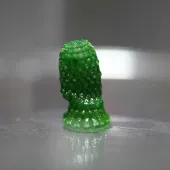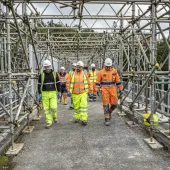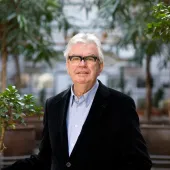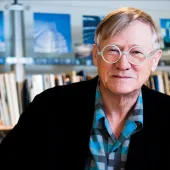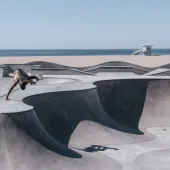Restoration of iconic concrete tower mural continues
Conservation specialists, DBR has shared images as work continues on the restoration of the Equality-Harmony mural in Haringey, London. Created in 1986 by artist Gülsün Erbil, the mural occupies the exterior face of a five-storey concrete refuse chute on the side of Tangmere House residential block, part of the Broadwater Farm Estate. The mosaic mural is 20m high and 5m wide, comprised of glass, and weighing in at around 50 tonnes.
The mural's imagery celebrates the universal values of peace, equality, harmony, and community, linked by a rainbow and a musical stave running the full height of the work. The motifs narrate a geographic transition from global to local, starting with the two hemispheres at the top of the composition, followed by the map of the UK, the river Thames, and the London skyline and finally to the buildings of the estate, its people, and the activities they enjoy.
Erbil said of this work: “This representation of nature and abstract figures throughout suggests a world where everything is functional, harmonious, free, and equal. This vision – of love, peace, harmony, and equality among all races – resonates as the mural's underlying anthem, leading us toward change.”
Following post-Grenfell safety checks and consultation with residents, Tangmere block, the home of the mural, was scheduled for demolition. In 2022, the mural was granted Grade II listed status by Historic England and, as such, needed to be preserved and restored while demolition works took place to make way for new high-quality council housing. DBR was approached and subsequently hired to record, repair, and conserve this important piece of London’s contemporary social history that was commissioned following the Broadwater Farm riot in 1985.
Adrian Attwood, DBR’s executive director, said “DBR is honoured to be involved in this project to rescue and conserve such an important landmark of London’s social heritage. We’re proud to have a longstanding association with Historic England and to play our part in protecting Britain’s buildings. The Broadwater Peace Mural is representative of the community that helped create it. The piece is a testament to the social justice campaign that followed the 1985 riots and is an important symbol of community spirit. It is only right that it is properly conserved.”
The conservation specialists worked with the demolition contractor Hughes & Salvidge to erect bespoke scaffolding to the mural, allowing conservators to get close enough to create a visual and tactile survey of the mural. Next, the DBR team drafted a condition report which allowed them to evaluate the condition of the mosaic and the subsequent treatment requirements needing to be carried out. DBR worked with Haringey Council’s Project Management team and conservation officer within the constraints of the listing requirements stipulated by Historic England.
DBR mapped the mosaic according to the artist’s original margins, dividing the mural into a total of 21 approximately 900mm height sections weighing in at 2.5 tonnes each. Following this, the dismantling process was undertaken, one section at a time, with each piece salvaged in between different demolition phases.
To ensure the historic fabric was protected during the cutting and lifting process, DBR conservators created a systematic blanket system for each section. Inspired by the mosaic protection process commonly used on salvaged Roman mosaics, a three-layered protective blanket was applied for each section. The first layer consists of cotton gauze and natural wheat-starch paste. This was followed by a layer of liquid rubber and finally a layer of plaster. These three layers act to absorb any vibration or shock to the mosaic during the cutting and lifting process. This ‘safety’ blanket also serves to hold any mosaic pieces in place in case they shift during the process. The blanket left one strip of mosaic exposed – acting as a precise guide for the cutting blade.
The cutting process for the 21 mosaic sections was a collaboration between DBR and Hughes and Salvidge. Large diamond cutting wheels were used to carefully wet cut each section. This started with a smaller blade for pilot cuts at each corner, then a larger blade was used to cut through the mass of concrete. Before final cuts were made, the concrete sections were attached to a crane, which provided the necessary tension to ensure no wayward movement during cutting. Once all lines were cleanly cut, the crane lifted the individual 2.5-tonne mosaic sections to ground level, where DBR’s team of conservators and a forklift greeted and guided the mosaic section to an on-site purpose-built workshop.
Once dismantled, the mural was moved to the site workshop, set up by Haringey Council, where DBR has set to work on the cleaning and conservation process of the glass mural. Here, more documentation, gentle cleaning, and delicate work to the mural sections took place. Each section was meticulously cleaned with deionised water and light, conservation-grade, detergent where stronger agents were necessary. New tesserae will be sourced and found based on original colours identified during the survey period. This will allow for the conservation and repair of any damaged or missing tesserae to the entirety of the mural.
Following the conservation of the mural sections in the on-site conservation workshop, the mural will be carefully reinstated in a new location on the estate.
David Sherrington, programme director Broadwater Farm, Haringey Council, added: “The "Equality–Harmony" mural is part of Broadwater Farm’s social and cultural history. Preserving, restoring, and celebrating the mural is important to us and the Broadwater Farm Community. Together with our residents, we are bringing about the most wide-reaching improvements to the estate since it was built. The mural is very much part of the future of Broadwater Farm. We can’t wait to see it installed in its new home.”







